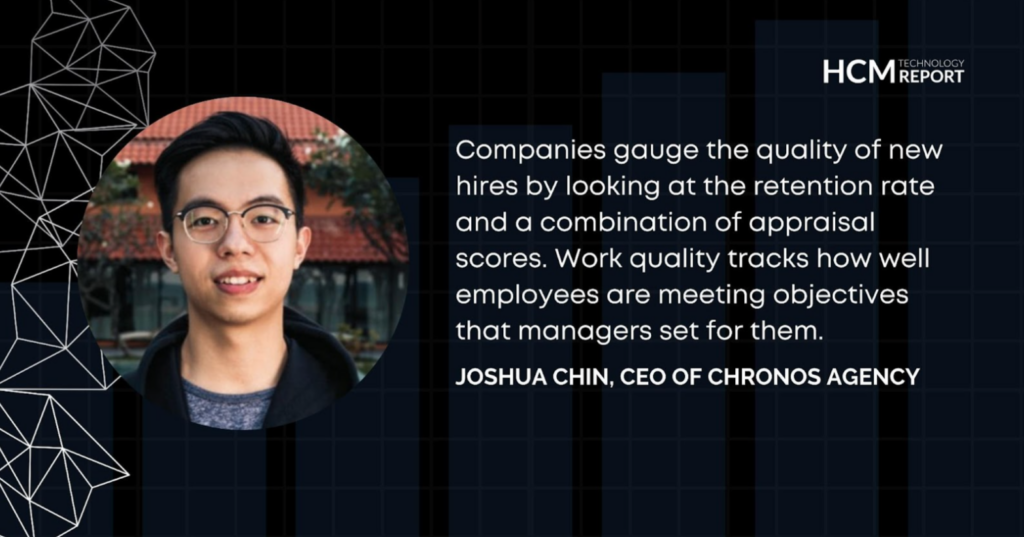To help you measure your talent acquisitions, we asked HR professionals and recruiting specialists this question for their best metrics. From the failure and retention rates of new hires to your demographic data, there are several ways you can measure how effective your talent acquisition efforts have been.
Here are nine talent acquisition metrics worth tracking:
-
- Failure & Retention Rates of New Hires
- Internal Mobility
- Source of Hire
- Number of Applications
- Offer Rate vs. Start Rate
- Submission to Interview Ratio
- Quality of Hire Formula
- Time from Application to Offer
- Demographic Data
Failure & Retention Rates of New Hires
Apply talent acquisition metrics for your business, mainly the one that measures performance. The new hire failure rate is the percentage of new employees who leave a company within a specified period, which indicates whether the recruiting is choosing suitable candidates.
Companies gauge the quality of new hires by looking at the retention rate and a combination of appraisal scores. Work quality tracks how well employees are meeting objectives that managers set for them. Utilize these processes to determine the effectiveness of performance in your organization and address any issues which may arise.
Joshua Chin, Co-founder & CEO, Chronos

Internal Mobility
Internal mobility is a great talent acquisition metric because it provides an overview of how your business’ talent development pipelines are faring. Having employees from within your company apply and be accepted for higher roles reduces the time, effort and cost associated with hiring externally, whilst also demonstrating the potential for growth within the business.
Tracking the number of employees hired from within will allow you to tweak and adjust your professional development programs to ensure that you’re providing existing employees with the tools necessary to take the next steps in their career.
Low levels of internal mobility might mean that your business is more prone to resignations, as employees leave for better roles or improved growth opportunities. Internal mobility and talent retention often go hand in hand, serving as two vital elements of long-term workplace culture.
Clare Jones, Marketing & HR Manager, OfficeSpaceAU
Source of Hire
“Source of hire” is an essential metric in talent acquisition. The source of hire metric provides details on the avenue in which a hired employee came to an organization. For organizations that leverage many different outlets to find talent, this metric can help determine where to invest talent attraction dollars supporting an intentional recruiting strategy.
From the lens of diversity recruiting, the ability of a talent acquisition team to assess the source of hire can provide core details that help shape an intentional diversity strategy. This metric may also shed light on process barriers that exclude specific demographics of people, helping drive equitable outcomes for job seekers and ultimately, employees.
Chelsea C. Williams, Founder & CEO, Reimagine Talent Co.

Number of Applications
The number of new candidates applying for your open positions. In order to scale your recruitment efforts and find the right people for your company, you need to track how many people are applying for each position on your website. When you track how many people are applying per position, you can see how much interest your open positions are generating. From here, you can better tailor your hiring process to attract the right candidates.
Karen Ebanks, Founder, Karan Real Estate
Offer Rate vs. Start Rate
When it comes to metrics, I personally believe that the days of dials, connections, emails or texts outbound do not matter. So often, recruiters are so focused on the numbers outbound that they lose track of the key to success: securing interviews and start dates. There are those that believe that providing an offer is the most important aspect to track in talent acquisition, but I disagree.
Interviews are vital in order to find the right person and learn from the process that what you’re truly looking for can’t always be found on paper. The more interviews you bring into the office or meet with virtually, the closer you will be to making an offer. Just as important, in my mind, is the number of starts.
The talent acquisition team needs to not only find the right fit, but get the candidate to the finish line of the hiring process. Building relationships and rapport will help the recruitment team turn the offer into a start because at the end of the day, while offers are great, no one wins without the start.
Megan Blanco, Internship Coordinator, Career Coach, Adjunct Faculty, University of Central Florida

Submission to Interview Ratio
Quality and efficiency in selecting the best candidates for interviews is a reflection of a healthy talent acquisition process. Test the health of your organization’s process by adopting the key metric of “Submission to Interview” ratio.
Simply put, if your recruiting staff submits 10 candidate resumes for interview consideration and only one resume is selected, you have performed at a very low rate of 10% and likely discouraged your hiring manager.
However, if your recruiting team submits three resumes and two are interviewed, you have achieved an excellent 67% “Submission to Interview” ratio. The benefits of such excellent ratios are many and include the acquisition of top tier talent, the productivity of hiring teams, the satisfaction of job seekers and the strengthening of your organization’s recruiting culture.
So, build quality pipelines of talent you can’t wait to hire as demonstrated by making your primary metric the “Submission to Interview” ratio.
Bill Gunn, Principal Consultant, G&A
Quality of Hire Formula
When it comes to talent acquisition metrics, it’s not only about “time to fill” and “offer acceptance rate”. The “quality of hire” (QoH) metric goes a long way since it measures the value new hires bring to your company, and it’s considered the holy grail of recruitment metrics.
Calculating this metric can help reduce company costs, and increase revenues in the long run. The major obstacles to measuring the quality of your hires, however, are a lack of time and lack of technology.
There is no absolute way to measure this metric, though common approaches include: performance appraisals, retention rates, recruiting managers’ satisfaction and even Employee-Lifetime-Value (ELV).
Some other approaches include the ramp-up period and the cultural fit of a new hire.
To quantify this, one possible formula to use is: QoH = Job Performance + Ramp-up Time + Employee Engagement + Cultural Fit) / N where N = number of variables (in this case, N = 4). To improve measurement, make sure you gather the right pre- and post-hire data points and optimize your recruitment workflow. AI tech can help here.
Yara Abboud, emcrey
Time from Application to Offer
I think that if a company has the ability to track from the time a candidate applies to the time an offer is made, this will be a huge step in diagnosing any potential hiring issues. It seems to be common use to track the time it takes to fill an open position, however that involves steps that may muddle what’s actually going on.
For example, if a person applies and it ends up taking three months to receive an offer due to delays and multiple interviews, that might contribute to a lower offer acceptance ratio.
Secondary to this would be the time to find a candidate, which allows the organization to see how long it takes to source certain types of candidates over others. Whereas time to offer from the date the person applies uncovers, for example, problems such as the recruiter not being able to get to the candidates fast enough, if the hiring managers are not giving responses back to the recruiter or candidates in enough time, if the interview process is taking too long, or if there are any other delays in making an offer.
Rollis Fontenot III, Founder, HR Maximizer Inc
Demographic Data
Comparing the demographic data of your talent pool to the demographic data of the areas where you’re hiring will provide insight into whether you’re attracting a diverse pool of candidates or you’re excluding certain groups of people.
For example, if you discover a gender imbalance in the number of applicants, you might want to review your job description to make sure you’re using inclusive language. You should also track how different groups advance in the recruitment success to flag potential bias in the process.
Simone Missagia, Marketing Director, Pulsely Limited
Authors
Recruit Smarter
Weekly news and industry insights delivered straight to your inbox.




